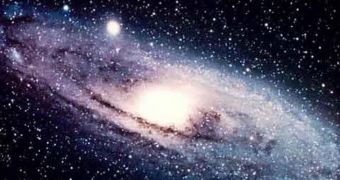A newly discovered so-called hypervelocity star stands to put the idea of living life in the fast lane in a whole new perspective. Thus, according to a team of scientists, this star travels through space at a speed of over 1 million miles per hour (about 1.6 million kilometers per hour).
The hypervelocity star is now referred to as LAMOST-HVS1. This is because the University of Utah-led team that found it did so with the help of the Large Sky Area Multi-Object Fiber Spectroscopic Telescope (LAMOST) in China.
The scientists explain that, when compared to other stars, LAMOST-HVS1 is a tad hyperactive, meaning that it journeys through space at impressive speeds. Presently, it is unclear whether this is because the star has some serious coffee addiction to overcome.
Evidence at hand indicates that, relative to our solar system, this hypervelocity star's speed is one of 1.4 million miles per hour (approximately 2.25 million kilometers per hour), EurekAlert informs.
When the speed of the center of the Milky Way is taken as the point of reference, the star's speed reaches some 1.1 million miles per hour (roughly 1.8 million kilometers per hour).
Over the past decade, the scientific community has documented the existence of about 20 such hypervelocity stars, of which the newly discovered LAMOST-HVS1 is said to be the second brightest and the closest to our good old planet.
Just for the record, it must be pointed out that, when researchers say that this star is the closest to our planet, they mean that the distance separating it from Earth is one of “just” 249 quadrillion miles (that's 249 million billions or 42,400 light years) from Earth.
LAMOST-HVS1 is said to have been around for “merely” 32 million years ago, which makes it fairly young, at least when compared to our sun, which is estimated to be about 4.6 billion years old.
What's more, the newly found hypervelocity star is estimated to be about 9 times more massive, 4 times hotter, and 3,400 times brighter – when observed from the same distance, that is – than our sun, the University of Utah-led team says.
Scientists hope that, by researching this star, they will be able to gain a better understanding of the Milky Way. “The hypervelocity star tells us a lot about our galaxy – especially its center and the dark matter halo. We gain insight from the star's trajectory and velocity, which are affected by gravity from different parts of our galaxy,” specialist Zheng Zheng explains.

 14 DAY TRIAL //
14 DAY TRIAL //